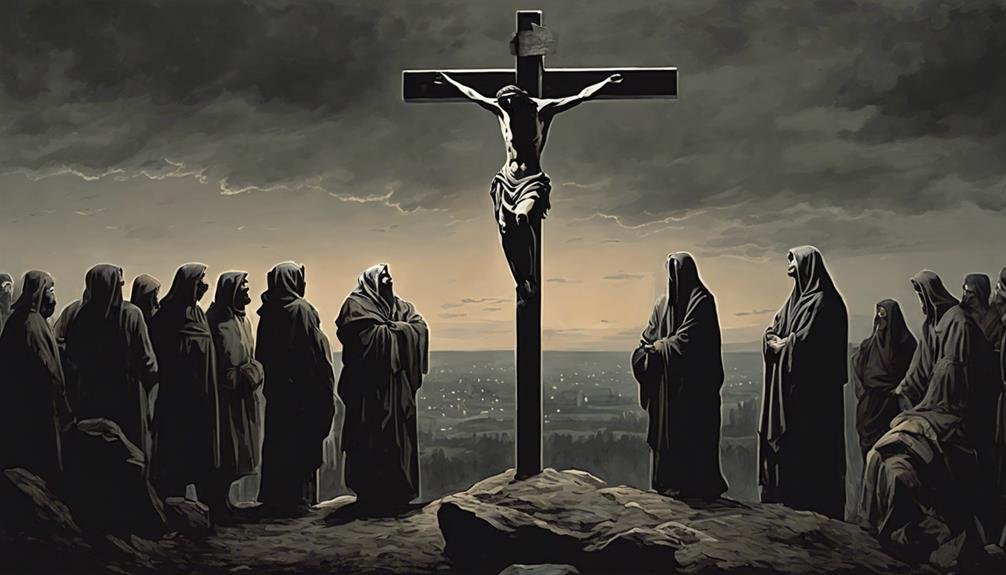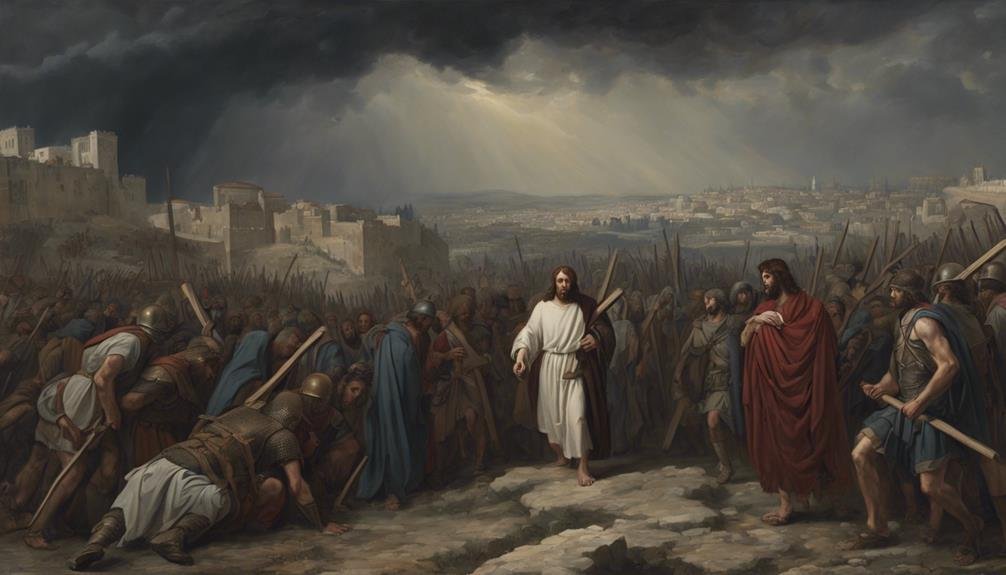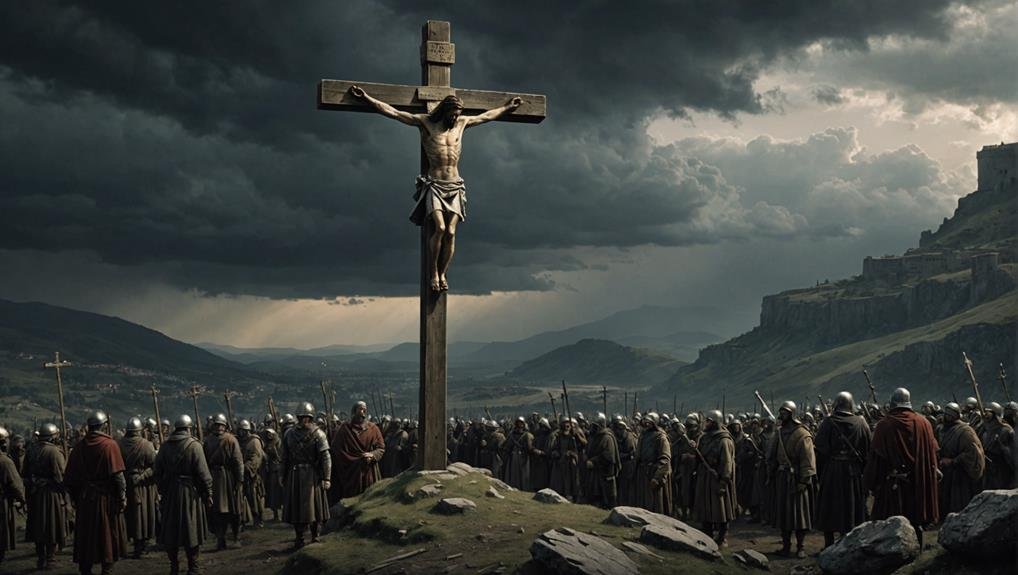When you consider Jesus dying on the cross, you’re looking at a moment that’s not just historical but deeply significant in Christian theology. It’s a story of immense suffering and ultimate sacrifice, where Jesus’ crucifixion under Roman rule fulfills prophecies and offers redemption for humanity’s sins. You might wonder how such a brutal event can be seen as an act of love or why it is a bridge between God and man. As you explore this further, you’ll find layers of meaning that touch on themes of sacrifice, prophecy, and spiritual freedom.
Key Takeaways
- Jesus’ crucifixion was a common Roman method of capital punishment used to maintain control and suppress dissent.
- Jesus was arrested in the Garden of Gethsemane, tried by the Sanhedrin and Pontius Pilate, and sentenced despite Pilate finding no fault.
- Jesus’ death on the cross is seen as the ultimate demonstration of God’s love, offering salvation and atonement for sins.
- Crucifixion fulfills ancient prophecies, providing a bridge between God and humanity, commemorated on Good Friday.
- Jesus’ sacrifice on the cross symbolizes redemption, spiritual freedom, and the pathway to holiness and closeness with God.
Crucifixion Narrative in the Gospels

The crucifixion narrative in the Gospels is a cornerstone of Christian theology, documented meticulously by Paul and the four canonical gospels. In the Gospel of Mark, you’ll find a detailed portrayal of Jesus’ suffering, highlighting his prediction of his death. As you read, you see Jesus dying on the cross, surrounded by supernatural occurrences, such as darkness covering the land from the 3rd to the 9th hour.
The Gospel of John offers a unique perspective, emphasizing Jesus’ control over his fate. Here, Jesus is offered wine mixed with myrrh before being crucified between two convicts. Each account provides distinct elements that enrich the understanding of Jesus’ crucifixion, illustrating both his humanity and divinity.
High priests play an essential role in the narrative, orchestrating the events leading to Jesus’ crucifixion. Their involvement underscores the tension between Jesus and the religious authorities of his time.
The Gospels collectively depict the crucifixion as a pivotal moment, setting the stage for Jesus’ Resurrection. This blend of prophecy, suffering, and supernatural events deepens your comprehension of Jesus’ ultimate sacrifice and its theological significance.
Historical Context of Crucifixion
Understanding Jesus’ crucifixion demands looking at the broader historical context of this brutal form of execution. Crucifixion was a common method of capital punishment under Roman occupation, particularly in the 1st century AD when Jesus died. This form of execution involved nailing or binding the condemned to a cross, leading to a slow and painful death. It served as a public spectacle to deter rebellion and control subject populations.
When Jesus died on the cross, it wasn’t just an isolated event but part of a larger Roman strategy to suppress dissent. The Romans used crucifixion widely across their empire, targeting criminals and those they deemed threats to their authority. The historical context of crucifixion reveals how the Romans exerted their power through fear and brutality.
Archaeological evidence and historical accounts confirm that crucifixion was practiced extensively in the ancient world. Jesus’ crucifixion, set against this backdrop, holds significant religious and cultural meaning. It illustrates the harsh realities of Roman rule and the lengths to which authorities would go to maintain order.
This historical context enriches your understanding of the event’s profound impact on history and faith.
Events Leading to the Cross

Before Jesus was crucified, a sequence of pivotal events unfolded, sealing his fate. After his arrest in the Garden of Gethsemane, Jesus faced a series of trials. He was brought before the Sanhedrin, then to Pontius Pilate, the Roman governor.
Despite Pilate finding no fault in Jesus, he bowed to public pressure and sentenced Him to be crucified.
As described in the New [WRITINGS], Jesus was offered wine mixed with myrrh or gall, a customary act meant to numb the pain. Refusing the drink, He was crucified between two convicts.
The crucifixion took place from the 3rd to the 9th hour, with a sign reading “King of the Jews” affixed above His head.
During those agonizing hours, the Gospels detail various reactions from the crowd, including mockery and sorrow. Supernatural events also marked the moment of Jesus’ death—darkness covered the land, and the temple veil was torn in two.
These occurrences underscored His sacrifice’s gravity and immense love for us. Each Gospel offers unique perspectives on these events, providing a [DETAILED] account of the steps leading to Jesus’ death on the cross.
Religious Significance
Through the lens of Christian theology, Jesus’ crucifixion holds profound religious significance. Jesus Christ’s death on the cross is seen as the ultimate demonstration of God’s love for humanity. According to the Gospel, this act of sacrifice bridges God and man, offering salvation and eternal life to believers. Christians would argue that the death of Jesus fulfills ancient prophecies and provides atonement for humanity’s sins.
One of the central themes of Jesus’ crucifixion is redemption. Jesus’ death is a powerful symbol of sacrifice, showing the lengths to which God would go to save humanity. It is commemorated annually on Good Friday, a day of reflection and reverence within the Christian community.
| Symbol | Significance |
|---|---|
| The Cross | The central symbol of faith and salvation |
| Good Friday | Annual commemoration of Jesus’ crucifixion |
| Prophecies | Fulfilled by Jesus’ death |
| Atonement | Jesus’ sacrifice for humanity’s sins |
Redemption and Freedom

The profound religious significance of Jesus’ crucifixion naturally leads us to explore the themes of redemption and freedom. When Jesus was crucified and died on the cross, it wasn’t just a historical event; it was a divine act that took place to redeem humanity from the bondage of sin. According to Christian belief, Jesus’ death was the ultimate price paid for humanity’s sins, fulfilling the prophecies and promises of the Old Scripture.
Through this sacrifice, believers are set free from the control of sin. The shedding of Jesus’ blood on the cross was necessary for atonement, offering a means to be purified and sanctified. This redemption isn’t temporary but provides true and lasting freedom from the power of sin. By accepting Jesus’ sacrifice, you can experience liberation from the spiritual chains that previously bound you.
Jesus’ death on the cross signifies more than just physical suffering; it symbolizes the pathway to holiness and closeness with God. This act of redemption allows you to draw nearer to God, embracing a life of holiness and sanctification. Ultimately, Jesus’ crucifixion offers redemption and the profound experience of spiritual freedom.
Conclusion
You’ve journeyed through the narrative of Jesus’ crucifixion, understanding its historical and spiritual weight. By grasping the events leading to the cross, you see the ultimate sacrifice and its profound religious significance. Jesus’ death symbolizes redemption and freedom, bridging the gap between humanity and God. This act of love continues to inspire and guide believers, reminding them of the depth of God’s love and offering a pathway to spiritual closeness and eternal hope.
FAQs
Why did Jesus die on the cross, according to Christian belief?
According to Christian belief, Jesus’ death on the cross was the ultimate act of love and sacrifice. Christians believe that Jesus died to atone for the sins of humanity, offering salvation and reconciliation with God. His crucifixion is seen as the fulfillment of prophecy, and through His death, believers are offered the hope of eternal life and forgiveness of sins.
Key Beliefs:
- Atonement for Sin: Jesus’ death served as a sacrifice for humanity’s sins.
- Fulfillment of Prophecy: Seen as the fulfillment of Old Testament prophecies.
- Salvation and Forgiveness: Provides salvation and the hope of eternal life.
What is the significance of Jesus’ crucifixion in Christianity?
The crucifixion of Jesus is central to the Christian faith and symbolizes:
- Redemption and Sacrifice: Jesus’ death is the ultimate sacrifice, redeeming humanity from sin.
- Love and Grace: It demonstrates God’s immense love for the world, as described in John 3:16: “For God so loved the world that He gave His only Son.”
- Victory Over Death: Christians believe that Jesus’ resurrection after His death signifies victory over sin and death, offering hope of eternal life.
Significance:
- Redemption: Jesus’ death redeems humanity.
- Love and Grace: A profound expression of God’s love.
- Victory Over Death: Represents hope in Jesus’ resurrection.
What happened during Jesus’ crucifixion?
The crucifixion of Jesus took place after His arrest, trial, and sentencing by the Roman governor Pontius Pilate. Key events include:
- Carrying the Cross: Jesus was forced to take His cross to the site of His crucifixion at Golgotha.
- Nailing to the Cross: Jesus was nailed through His hands and feet to the cross, where He hung for hours.
- His Death: After several hours, Jesus died, uttering the words, “It is finished” (John 19:30), signifying the completion of His mission to redeem humanity.
Key Events:
- Jesus carried His cross to Golgotha.
- He was nailed to the cross and hung for hours.
- He died after uttering, “It is finished.”
What does “It is finished” mean when Jesus said it on the cross?
When Jesus said, “It is finished” (John 19:30), He signified the completion of His mission on Earth. In Christian theology, this phrase indicates that Jesus had fulfilled the purpose of His coming—to provide a path to salvation by atoning for humanity’s sins through His sacrificial death.
Meaning of “It is finished”:
- Completion of His Mission: Fulfillment of God’s plan for salvation.
- Atonement for Sins: Indicates that the penalty for sin had been paid in full.
What happened after Jesus died on the cross?
After Jesus died, several significant events occurred:
- The Temple Curtain Tore: According to the Gospel accounts, the temple curtain was torn in two from top to bottom, symbolizing that the barrier between God and humanity had been removed.
- Jesus’ Burial: Jesus was taken down from the cross and placed in a tomb by Joseph of Arimathea.
- Resurrection: Jesus rose from the dead three days later, an event celebrated as Easter in Christianity. His resurrection is seen as the defeat of death and sin, affirming believers’ hope of eternal life.
Post-Crucifixion Events:
- Temple Curtain Tore: Signifying the removal of the barrier between God and humanity.
- Burial in a Tomb: Jesus was buried and laid to rest.
- Resurrection: Jesus rose from the dead, affirming the hope of salvation.

